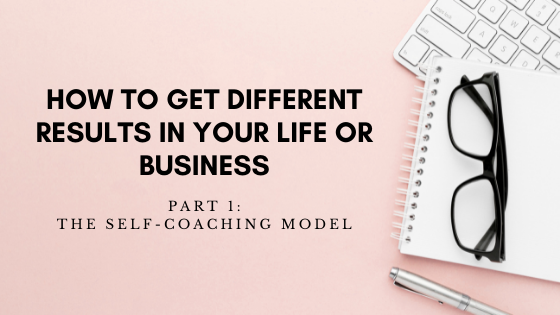How to get different results in your life or business - Part 1: The self-coaching model

Who doesn’t wish they could get a better life? A richer life? (And I’m not just talking about money here.)
In this 2-part blog post on ‘How to get different results in your life (and your business)’ I’m going to share with you something that I’ve discovered recently that will help you take your life or business to the next level.
Ready? Let’s jump in!
Part 1: The self-coaching model
There’s a tool that I discovered recently that has blown my mind. It’s called the self-coaching model.
The idea behind it is that our thoughts create our feelings, our feelings create our actions, and our actions create our results.
Thoughts > Feelings > Actions > Results
To make real change in our life (and that includes our business) we essentially need to change the way we feel AND the way we think because together they can form our (limiting) beliefs.
But first we must gain awareness because I don’t know about you, but sometimes I have no clue why I’m getting the results (or lack thereof) I’m getting. And sometimes I procrastinate, I don’t do those things I’m supposed to be doing, and I KNOW that it’s bad, but I can’t help myself, and I just don’t know why. Well, if that’s you too now at least we have the self-coaching model to help us gain that awareness we sometimes lack.
Let’s start with the five areas we’re going to explore as part of the model:
-
Circumstances: these are fact, meaning: they are measurable. For example when I say “I’m 1.64m tall”, that’s a fact. Circumstances are, as a result, neutral. They’re neither good nor bad.
-
Thoughts: they are the sentences (or voice) in our head.
-
Feelings: they are the vibrations in our body. In the context of the self-coaching model it is best to describe them with one word. For example: excited, anxious, angry, happy, resentful, confident, etc.
-
Actions: they’re what we do, what we don’t do (inactions), or how we react (reactions).
-
Results: they’re the outcomes of our actions, inactions or reactions.
Alright, so now that we’ve covered the basics, how do we actually use all of this?
1) First, write the letters C (circumstances), T (thoughts), F (feelings), A (actions), R (results) as one column on a sheet of paper like so:
C -
T -
F -
A -
R -
2) Then fill in one of the lines with what you want to solve. It can be any line. Start with the one you noticed first.
Here’s one of my own recent examples:
C -
T -
F -
A - Not drawing in my sketchbook. (In this case you’ve guessed it: it’s an inaction.)
R -
3) Finally, fill in the remaining lines.
So to carry on with my personal example:
C - Sketchbook practice.
T - When I’m drawing in my sketchbook, I’m not doing something that generates money.
F - Demotivated.
A - Not drawing in my sketchbook.
R - No experimentation, no new personal work, limited play, limited growth.
With this particular example I found it easier to write the result second, then go back up to the circumstances (remember: they’re neutral), followed by the thought, and finally the feeling.
I also picked that example because 1) as I said earlier, it’s a real one, and 2) I read a lot of comments online and on social media of other artists who lament at their lack of sketchbook practice so I thought that it could be a useful example.
Now let’s pause a moment and see what we learned (and by ‘we’, really, I mean ‘I’).
After doing this exercise I realised that my lack of sketchbook practice (inaction) was coming, 90% of the time, from the thought that when I do draw in my sketchbook I’m not doing something that generates money in an obvious and/or immediate way. And in turn, that thought creates a feeling of demotivation when it comes to drawing in my sketchbook, and (I didn’t write this one down to keep things simple but) sometimes even guilt if I’m drawing in my sketchbook instead of working on more business-related tasks. Hmmm… Interesting…
We’ve gained massive awareness, haven’t we? Now what?
Well, now that we’ve put our finger on our thoughts and feelings, we have to change them in order to change our results.
How do we do this?
That’s what we’re going to talk about in Part 2 (coming soon!) so stay tuned!
